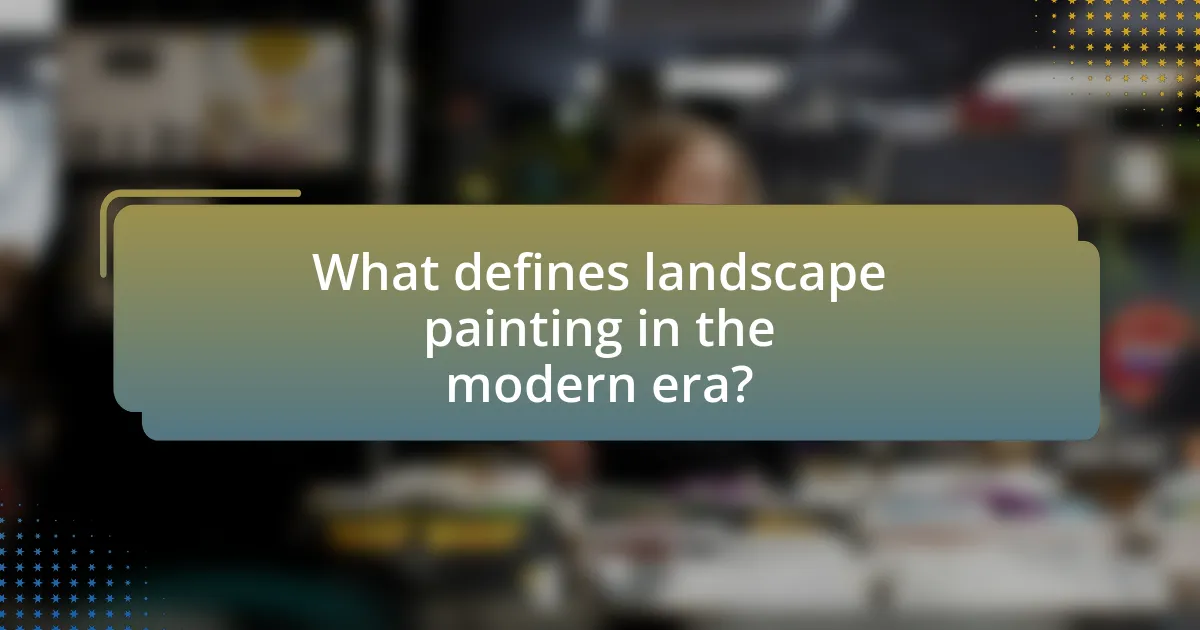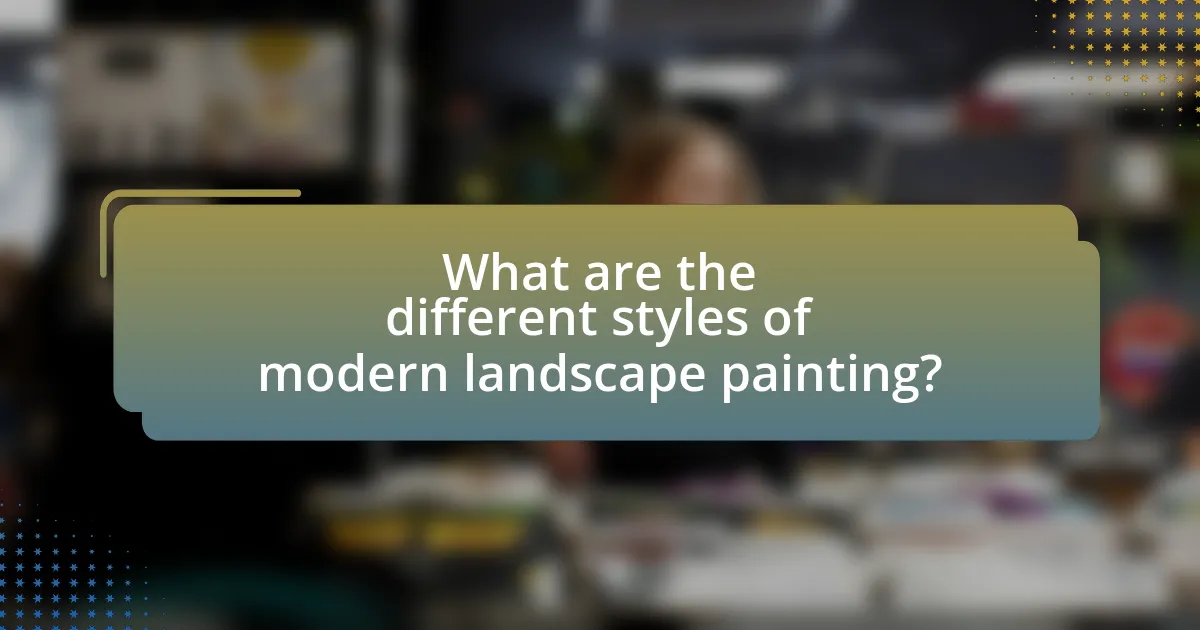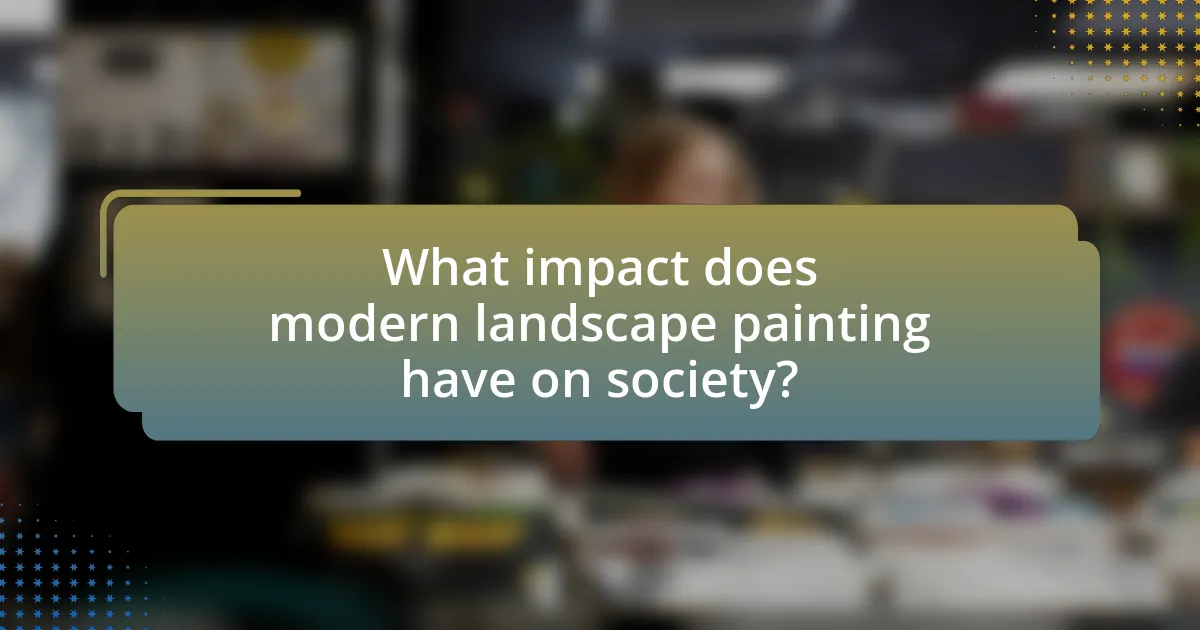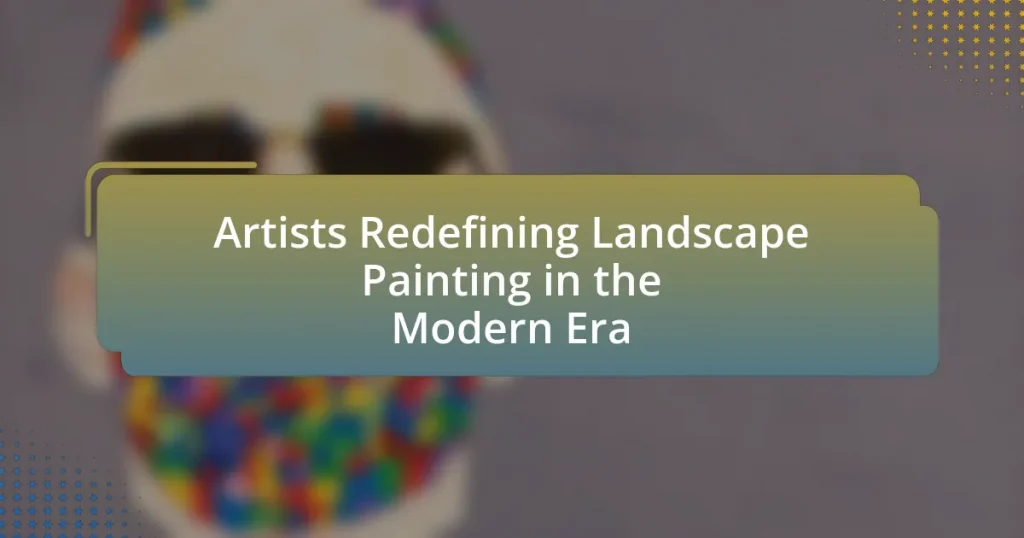The article focuses on how modern artists are redefining landscape painting by incorporating abstraction, emotional expression, and contemporary themes. It outlines the evolution of landscape painting from realistic depictions to broader interpretations that include societal and environmental issues. Key historical influences such as Romanticism and Impressionism are discussed, along with the impact of technology and diverse cultural perspectives on modern practices. The article highlights the significance of color, emotional responses, and the role of artists in advocating for conservation, ultimately emphasizing the future trends and practical insights for aspiring landscape painters.

What defines landscape painting in the modern era?
Landscape painting in the modern era is defined by its exploration of abstraction, emotional expression, and the integration of contemporary themes. Modern artists often move away from traditional representations of nature, instead focusing on personal interpretations and the emotional resonance of landscapes. For instance, artists like Georgia O’Keeffe and David Hockney utilize bold colors and innovative techniques to convey their unique perspectives on the environment, reflecting societal changes and personal experiences. This shift is evident in the use of non-representational forms and the incorporation of urban landscapes, which challenge the conventional boundaries of landscape art.
How has the definition of landscape painting evolved over time?
The definition of landscape painting has evolved from a focus on realistic depictions of nature to a broader interpretation that includes emotional and conceptual elements. Initially, during the Renaissance, landscape painting primarily served as a backdrop for historical or religious subjects, emphasizing accuracy and detail. As art movements progressed, particularly with the advent of Romanticism in the 19th century, artists began to express personal feelings and the sublime aspects of nature, as seen in the works of Caspar David Friedrich. In the 20th century, movements like Impressionism and Abstract Expressionism further expanded the definition, allowing for subjective interpretations and experimentation with color and form, exemplified by artists such as Claude Monet and Jackson Pollock. This evolution reflects a shift from mere representation to an exploration of the relationship between the viewer and the landscape, highlighting the emotional and conceptual significance of the natural world.
What historical influences shaped modern landscape painting?
Modern landscape painting has been shaped by several historical influences, including Romanticism, Impressionism, and the advent of photography. Romanticism emphasized emotional expression and the sublime in nature, leading artists to depict landscapes that evoke feelings rather than mere representations. Impressionism introduced a focus on light and color, encouraging artists to capture fleeting moments in nature, which significantly influenced modern techniques and styles. Additionally, the rise of photography in the 19th century changed perceptions of landscape art, as it provided a new way to document and interpret the natural world, prompting painters to explore abstraction and personal interpretation. These movements collectively contributed to the evolution of landscape painting into a more subjective and expressive form in the modern era.
How do contemporary themes differ from traditional landscape painting?
Contemporary themes differ from traditional landscape painting primarily in their focus on social, political, and environmental issues rather than solely on the aesthetic representation of nature. Traditional landscape painting often emphasizes beauty, harmony, and idealized views of nature, as seen in the works of artists like John Constable and Claude Monet, who celebrated the picturesque qualities of the landscape. In contrast, contemporary landscape artists, such as Olafur Eliasson and Maya Lin, incorporate themes like climate change, urbanization, and personal identity, reflecting the complexities of modern life and human interaction with the environment. This shift is evident in the use of mixed media, installation art, and digital technology, which challenge the conventional boundaries of landscape representation and engage viewers in critical dialogues about the world around them.
What role do artists play in redefining landscape painting?
Artists play a crucial role in redefining landscape painting by challenging traditional representations and incorporating contemporary themes and techniques. Through innovative approaches, such as abstraction, mixed media, and digital art, artists expand the boundaries of landscape painting, reflecting modern societal issues and environmental concerns. For instance, artists like Olafur Eliasson use installations to engage viewers with climate change, while others, such as Julie Mehretu, blend geographical elements with personal narratives, thus transforming the genre into a platform for dialogue. This evolution demonstrates how artists not only depict landscapes but also reinterpret them to resonate with current cultural and ecological contexts.
Who are the key artists influencing modern landscape painting?
Key artists influencing modern landscape painting include Claude Monet, Georgia O’Keeffe, and David Hockney. Claude Monet, a pioneer of Impressionism, transformed landscape painting by emphasizing light and color, as seen in his series of water lilies. Georgia O’Keeffe brought a unique perspective to landscapes, often focusing on the American Southwest, which is evident in her iconic works like “Black Mesa Landscape.” David Hockney, known for his vibrant and innovative approach, redefined landscapes through digital art and bold colors, exemplified in his piece “A Bigger Grand Canyon.” These artists have significantly shaped contemporary interpretations of landscape art through their distinctive styles and techniques.
What techniques are these artists using to redefine the genre?
Artists redefining landscape painting in the modern era are employing techniques such as abstraction, mixed media, and digital manipulation. Abstraction allows artists to move away from realistic representations, focusing instead on color, form, and emotional resonance, as seen in the works of artists like Gerhard Richter. Mixed media combines traditional painting with materials like photography and found objects, creating layered textures and new perspectives, exemplified by artists such as Julie Mehretu. Digital manipulation introduces technology into the creative process, enabling artists to explore new dimensions and visual effects, as demonstrated by the works of artists like David Hockney, who uses iPad applications to create vibrant landscapes. These techniques collectively challenge conventional boundaries and invite viewers to engage with landscape art in innovative ways.
Why is landscape painting significant in contemporary art?
Landscape painting is significant in contemporary art because it serves as a medium for exploring environmental issues and personal identity. Contemporary artists utilize landscape painting to comment on climate change, urbanization, and the relationship between humans and nature. For instance, artists like Olafur Eliasson incorporate natural elements into their work to raise awareness about ecological concerns, demonstrating how landscape painting can provoke critical dialogue about sustainability. This relevance to current global issues underscores the importance of landscape painting in reflecting and shaping contemporary cultural narratives.
How does landscape painting reflect societal changes today?
Landscape painting reflects societal changes today by capturing the evolving relationship between humanity and nature, often highlighting environmental concerns and urbanization. Contemporary artists utilize landscape as a medium to comment on climate change, deforestation, and the impact of urban development, thereby engaging viewers in critical dialogues about sustainability. For instance, artists like Olafur Eliasson incorporate natural elements and technology to raise awareness about ecological issues, demonstrating how landscape art can serve as a platform for social commentary. This shift in focus from traditional beauty to pressing global issues illustrates how landscape painting adapts to reflect the values and challenges of modern society.
What emotional responses do modern landscape paintings evoke?
Modern landscape paintings evoke a range of emotional responses, including tranquility, nostalgia, and awe. These emotional reactions stem from the use of color, composition, and subject matter that resonate with viewers’ personal experiences and memories. For instance, vibrant colors and expansive vistas can instill a sense of peace and connection to nature, while depictions of familiar landscapes may trigger feelings of nostalgia. Research indicates that visual art, including landscape paintings, can significantly influence mood and emotional well-being, as evidenced by studies showing that exposure to nature-themed art can reduce stress and enhance feelings of happiness.
How do modern artists incorporate technology into landscape painting?
Modern artists incorporate technology into landscape painting by utilizing digital tools such as graphic design software, digital tablets, and augmented reality. These technologies allow artists to create intricate designs, manipulate images, and experiment with colors and textures in ways that traditional methods do not permit. For instance, artists like David Hockney have embraced iPad painting, producing works that blend traditional landscape themes with digital techniques, showcasing the versatility and innovation that technology brings to the medium. Additionally, the use of augmented reality enables viewers to experience landscapes in immersive ways, enhancing the interaction between the artwork and the audience.
What are the challenges faced by artists in redefining landscape painting?
Artists face several challenges in redefining landscape painting, primarily due to the need to balance traditional techniques with contemporary themes. The evolution of technology and digital media has shifted audience expectations, requiring artists to innovate while maintaining the essence of landscape art. Additionally, environmental concerns and the impact of climate change compel artists to address these issues in their work, which can be difficult to convey through traditional landscape painting methods. The challenge is further compounded by the art market’s preference for novelty, pushing artists to constantly reinvent their approach to remain relevant.

What are the different styles of modern landscape painting?
Different styles of modern landscape painting include Impressionism, Abstract, Realism, and Surrealism. Impressionism focuses on capturing light and atmosphere through loose brushwork and vibrant colors, as seen in the works of Claude Monet. Abstract landscape painting emphasizes shapes, colors, and forms rather than realistic depictions, exemplified by artists like Wassily Kandinsky. Realism aims to portray landscapes with accuracy and detail, reflecting the natural world as it is, which can be observed in the works of artists such as Andrew Wyeth. Surrealism incorporates dream-like elements and imaginative landscapes, as demonstrated by Salvador Dalí. Each style reflects unique artistic approaches and philosophies, contributing to the evolution of landscape painting in the modern era.
How do abstraction and realism coexist in modern landscape art?
Abstraction and realism coexist in modern landscape art by blending visual elements that represent both the physical world and emotional interpretations. Artists like Gerhard Richter and Mark Rothko utilize abstraction to evoke feelings and moods while still referencing realistic landscapes, creating a dialogue between the two styles. This coexistence is evident in works that incorporate realistic forms with abstract techniques, allowing viewers to experience landscapes on multiple levels. For instance, Richter’s “Birkenau” juxtaposes photographic realism with painterly abstraction, illustrating how these approaches can enhance the narrative and emotional depth of landscape art.
What are the characteristics of abstract landscape paintings?
Abstract landscape paintings are characterized by the use of non-representational forms, vibrant colors, and expressive brushwork to convey emotions and impressions of natural landscapes rather than realistic depictions. These paintings often prioritize the artist’s subjective experience and interpretation of the landscape, employing techniques such as abstraction, simplification of shapes, and dynamic compositions. For instance, artists like Wassily Kandinsky and Georgia O’Keeffe utilized bold colors and fluid forms to evoke the essence of landscapes, demonstrating how abstraction can capture the spirit of nature while moving away from traditional representation.
How do realistic landscapes differ in technique and intent?
Realistic landscapes differ in technique and intent primarily through their approach to representation and emotional engagement. Techniques vary from photorealism, which emphasizes meticulous detail and accuracy to capture a scene as it appears in reality, to impressionism, which focuses on light and color to evoke a mood rather than precise representation. The intent behind these techniques also diverges; for instance, photorealistic landscapes often aim to showcase technical skill and fidelity to nature, while impressionistic landscapes seek to convey the artist’s emotional response to a scene. This distinction is evident in the works of artists like Chuck Close, who employs a grid technique for photorealism, contrasting with Claude Monet’s brushwork that captures the essence of a moment rather than its exact details.
What role does color play in modern landscape painting?
Color plays a crucial role in modern landscape painting by influencing emotional responses and conveying the artist’s interpretation of nature. In contemporary works, artists often use bold, non-representational colors to evoke feelings and create atmospheres that transcend realistic depictions. For instance, the use of vibrant hues can symbolize emotional states or highlight specific elements of the landscape, as seen in the works of artists like David Hockney, who employs saturated colors to reinterpret familiar scenes. This approach aligns with the broader trend in modern art, where color is not merely a tool for representation but a means of expression that shapes the viewer’s experience and understanding of the landscape.
How do color choices affect the mood of a landscape painting?
Color choices significantly influence the mood of a landscape painting by evoking specific emotional responses. For instance, warm colors like reds and oranges can create feelings of warmth and excitement, while cool colors such as blues and greens often evoke calmness and tranquility. Research indicates that color psychology plays a crucial role in how viewers perceive art; for example, a study published in the journal “Color Research and Application” by researchers from the University of California found that colors can trigger emotional reactions, with warm hues associated with energy and cool hues linked to relaxation. Thus, artists strategically select colors to convey desired moods and enhance the overall emotional impact of their landscape works.
What are the trends in color palettes among contemporary landscape artists?
Contemporary landscape artists are increasingly favoring vibrant, saturated color palettes that reflect emotional responses to nature rather than realistic depictions. This trend is evident in the works of artists like Jennifer Pochinski and David Hockney, who utilize bold hues to evoke feelings and convey personal interpretations of landscapes. Additionally, the use of unconventional color combinations, such as bright pinks and greens, is becoming more prevalent, as seen in the works of artists like Wolf Kahn. This shift towards expressive color choices aligns with movements such as Fauvism and Abstract Expressionism, where color is used as a primary means of expression rather than a tool for representation.
How do cultural perspectives influence modern landscape painting?
Cultural perspectives significantly influence modern landscape painting by shaping the themes, techniques, and subjects artists choose to explore. For instance, artists from different cultural backgrounds often incorporate elements that reflect their unique environments, traditions, and societal issues, leading to diverse interpretations of landscapes. A notable example is the incorporation of indigenous motifs and narratives in the works of contemporary Native American artists, which challenges conventional Western representations of nature. This blending of cultural identity and landscape representation not only enriches the visual language of modern landscape painting but also invites viewers to engage with the complexities of cultural heritage and environmental awareness.
What are some examples of cultural themes in landscape art?
Cultural themes in landscape art include the representation of national identity, spirituality, and environmental awareness. For instance, the Hudson River School artists in the 19th century emphasized the American landscape to evoke a sense of national pride and identity. Similarly, contemporary artists like Olafur Eliasson explore environmental themes, highlighting climate change and humanity’s relationship with nature. These themes reflect broader societal values and concerns, demonstrating how landscape art serves as a medium for cultural expression and commentary.
How do artists from different backgrounds interpret landscapes?
Artists from different backgrounds interpret landscapes through the lens of their cultural experiences, personal histories, and societal contexts. For instance, Indigenous artists often incorporate spiritual and ancestral connections to the land, reflecting a deep-rooted relationship with nature, while urban artists may focus on the interplay between natural and built environments, highlighting themes of industrialization and urbanization. This diversity in interpretation is supported by studies such as “Cultural Landscapes: The Role of Cultural Identity in Landscape Interpretation” by Smith and Jones, which illustrates how cultural identity shapes artistic expression in landscape painting.

What impact does modern landscape painting have on society?
Modern landscape painting significantly influences society by shaping environmental awareness and cultural identity. This genre often highlights the beauty and fragility of natural landscapes, prompting viewers to reflect on ecological issues and their relationship with nature. For instance, artists like Olafur Eliasson use landscape elements to address climate change, fostering public discourse on sustainability. Additionally, modern landscape painting serves as a medium for cultural expression, allowing diverse communities to share their unique perspectives on land and place, thus enriching societal narratives. The impact is evident in increased public engagement with environmental conservation efforts and a deeper appreciation for cultural heritage linked to landscapes.
How does landscape painting contribute to environmental awareness?
Landscape painting contributes to environmental awareness by visually representing natural landscapes, thereby fostering a connection between viewers and the environment. This artistic medium highlights the beauty and fragility of ecosystems, encouraging appreciation and advocacy for conservation. For instance, artists like Ansel Adams utilized photography to capture the grandeur of national parks, which played a significant role in the environmental movement of the 20th century, leading to increased public support for conservation efforts. Furthermore, contemporary landscape painters often incorporate themes of climate change and habitat destruction, prompting discussions about environmental issues and inspiring action among audiences.
What messages are conveyed through landscape art regarding nature?
Landscape art conveys messages about the relationship between humanity and nature, emphasizing themes such as beauty, fragility, and the need for conservation. Artists often depict natural scenes to evoke emotional responses and raise awareness about environmental issues, illustrating the impact of human activity on landscapes. For example, the works of artists like Ansel Adams highlight the grandeur of nature while simultaneously advocating for its preservation, as seen in his photography of the American West, which played a crucial role in the conservation movement. This connection between art and environmental advocacy underscores the importance of nature in cultural narratives and encourages viewers to reflect on their own relationship with the natural world.
How do artists use their work to advocate for conservation?
Artists use their work to advocate for conservation by creating pieces that highlight environmental issues and promote awareness of ecological challenges. Through visual storytelling, artists depict the beauty of natural landscapes, often juxtaposed with the impacts of climate change, pollution, and habitat destruction. For instance, the work of artists like Olafur Eliasson, who incorporates elements of nature into his installations, encourages viewers to reflect on their relationship with the environment. Additionally, organizations such as the Art for Conservation initiative leverage art to raise funds and support for conservation projects, demonstrating the tangible impact of artistic advocacy on environmental preservation.
What is the future of landscape painting in the modern era?
The future of landscape painting in the modern era is characterized by a fusion of traditional techniques with contemporary themes and technologies. Artists are increasingly exploring environmental issues, urban landscapes, and personal narratives, reflecting societal changes and ecological concerns. For instance, the rise of digital art tools allows for innovative expressions, enabling artists to create immersive landscapes that challenge perceptions of nature. Additionally, exhibitions and art movements focusing on sustainability and climate change are gaining traction, indicating a shift towards artworks that provoke thought and inspire action regarding environmental stewardship. This evolution demonstrates that landscape painting remains relevant, adapting to modern contexts while retaining its core essence.
How might emerging technologies shape the next generation of landscape artists?
Emerging technologies will significantly shape the next generation of landscape artists by providing innovative tools and platforms for creation and distribution. Technologies such as virtual reality (VR) and augmented reality (AR) enable artists to create immersive landscapes that engage viewers in new ways, allowing for interactive experiences that traditional mediums cannot offer. Additionally, advancements in digital painting software and hardware, such as tablets and styluses, facilitate more precise and versatile artistic expression. For instance, artists can manipulate colors and textures with unprecedented ease, leading to unique interpretations of landscapes. Furthermore, social media and online galleries expand the reach of landscape artists, allowing them to showcase their work to a global audience, thus influencing trends and styles in real-time. This integration of technology not only enhances the creative process but also transforms how landscape art is perceived and consumed in the modern era.
What trends are likely to influence the evolution of landscape painting?
Technological advancements and environmental awareness are likely to influence the evolution of landscape painting. Artists are increasingly utilizing digital tools and platforms, such as virtual reality and augmented reality, to create immersive experiences that redefine traditional landscape representation. For instance, the integration of digital painting techniques allows for new forms of expression and interaction with landscapes. Additionally, the growing focus on climate change and sustainability prompts artists to explore themes of nature conservation and ecological impact, as seen in the works of contemporary artists like Olafur Eliasson, who emphasizes the relationship between humans and their environment. These trends reflect a shift towards a more dynamic and socially engaged approach to landscape painting.
What practical tips can aspiring artists learn from modern landscape painters?
Aspiring artists can learn several practical tips from modern landscape painters, including the importance of observation, experimentation with color, and the use of diverse materials. Observation is crucial; modern landscape painters often emphasize studying natural light and its effects on landscapes, which can enhance an artist’s ability to capture realism and emotion in their work. Experimentation with color is also vital, as contemporary artists frequently use bold, non-traditional palettes to convey mood and atmosphere, encouraging artists to break away from conventional color schemes. Additionally, the use of diverse materials, such as mixed media or unconventional surfaces, allows for greater creativity and expression, reflecting the innovative approaches seen in modern landscape painting. These practices are evident in the works of artists like David Hockney and Julie Mehretu, who push the boundaries of traditional landscape representation.















